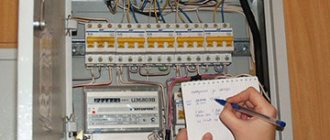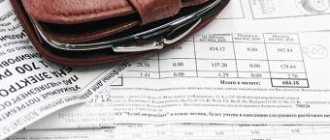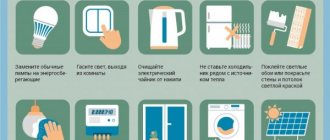The essence of the reform of RAO UES
Before moving on to a description of the components of the electricity tariff, we will briefly outline the essence of the RAO UES reform.
The company that operated until 2002 (RAO) was actually a monopolist in the Russian Federation, because combined all types of activities: from the production and transmission of electricity to its distribution and sale. Accordingly, the cost of the electricity tariff was set by the state, represented by the Federal Tariff Service, which was the main prerequisite for the reform, because private investors did not invest money in this industry, and it required serious modernization. The essence of the reform was to gradually move from tariff regulation to tariff formation using a market method, and for this it was necessary to get away from the monopoly by creating this very market. As a result of the reform, generating companies (electricity production), electric grid companies (electricity transmission), a system operator of the unified energy system (centralized control of the energy system), and energy sales companies with the status of guaranteed suppliers (sale of electricity to consumers) were created.
Electricity pricing for legal entities and entrepreneurs
Issues regarding the procedure for calculating prices and electricity tariffs for legal entities and entrepreneurs are of great importance for planning for future periods and managing the current activities of any enterprise. This issue is especially relevant for energy-intensive industries and facilities for which the share of expenses for paying for electrical energy and power in the final cost of production is large.
Previously, until 2006, all electrical energy was supplied to legal entities and entrepreneurs at regulated prices (tariffs). That is, tariffs were approved at the level of the local executive authority in the field of state regulation of tariffs (in different regions these organizations are called differently - regional energy commission, committee on tariffs and prices, regional tariff service, etc.). However, in the mid-2000s, energy reform took place in Russia and the so-called “liberalization” of electricity prices took place. And prices for electrical energy for legal entities and entrepreneurs ceased to be regulated and were allowed to float freely.
Of course, the procedure for their calculation remained regulated, but some components of electricity prices became “floating” and their final values began to depend on various competitive factors. In this section we will consider the main issues related to the procedure for calculating and using electricity prices for legal entities and entrepreneurs.
It is worth noting separately that most of the components of the final electricity tariffs for legal entities continue to be approved at the regional and federal levels even now. Moreover, most of the final electricity tariff remained regulated. If we talk about the specific components of tariffs in numbers, then in the final price for electricity for any legal entity, on average, at least 50% is occupied by the share of regulated tariffs, and the remaining part, accordingly, is variable.
Below we will look at some articles that will help you understand the issue of pricing for legal entities and entrepreneurs.
- The cost of electricity for enterprises: what it consists of and how it is determined
This article discusses general issues of the procedure for calculating the cost of electricity for enterprises using prices for legal entities and entrepreneurs: how it is determined, by whom it is calculated and how to check it.
- Tariffs and prices for electricity for enterprises, organizations and industrial companies
This article discusses the issues of determining the tariff (price) for electrical energy (power) for industrial enterprises, organizations, legal entities and entrepreneurs. How are they calculated, where are they published, is it possible to check and more.
- Voltage levels: physical and economic implications for the consumer
This article discusses the concept of voltage level and tariff voltage level: how they are determined and in what document it is recorded. What entails the use of an incorrect tariff voltage level in settlements with the consumer.
- Hourly profile of electrical energy consumption (power profile)
For this reason, consumers with a maximum power of over 670 kW must have electricity metering devices that allow them to store the power profile. How can a consumer take readings from such an electricity meter? The answers are in this article.
- Maximum power reserve: procedure for determination and payment
Over the past few years, there have been very active discussions at the level of the Government of the Russian Federation about the beginning of the application of a new payment scheme for consumed electrical energy for consumers - legal entities. Those consumers who do not fully use the maximum power allocated to them are required to pay a reserve (the difference between the actual and allocated power) in favor of the electric grid company or electricity supplier. For more detailed information on how it is planned to determine the power reserve and its cost, read this article.
- Electricity price for enterprises: how to check the cost per kilowatt
In this article, we looked at the issues of checking the cost of electricity for an enterprise, which is calculated by the electricity supplier. We also considered the actions of the consumer if he identified inconsistencies and errors in calculating the cost and price of electricity.
Read this article and don't be fooled!
Full list of section materials:
Why are electricity tariffs for enterprises constantly growing? Over the past five years (from 2015 to 2021), electricity tariffs for enterprises and organizations have increased by 40-50%. This is significantly higher than the official inflation rate. What are the reasons for such an increase in electricity prices?
Shevchenko Vadim Alexandrovich07/15/2020
Limit level of unregulated electricity prices
What is the maximum level of unregulated prices for electricity and capacity, how is it calculated and where is it applied - the answers are here. Links for downloading files.
Administrator05/27/2020
Electricity price for an enterprise: how to check kW
Electricity prices for businesses vary. Consumers may become confused by the variety of tariff options. How to check whether the cost has been calculated correctly and what to do if you find out that an error has crept in?
Administrator06/01/2017
Power reserve: determination and calculation of maximum consumption cost
Most representatives of enterprises and organizations have heard of such a concept as power reserve. But few people know what it really is. Here we will try to briefly talk about this concept and its features.
Administrator06/23/2015
Power profile of the enterprise's electricity: removal from the meter
Large enterprises and organizations very often hear words such as “power profile”, “hourly” from electricity suppliers. It seems like some strange and incomprehensible words. But in reality everything is quite simple. Let's figure out what it is.
Administrator05/08/2015
LV voltage level
Which consumers have the tariff level of LV voltage? The answers are here.
Administrator04/21/2015
Voltage level CH2 (10 kV)
Which consumers have the tariff voltage level CH2, which is also called the medium voltage level? Is it more profitable to pay using CH2 than using other voltage levels? We have provided the answers here.
Administrator04/21/2015
Voltage level CH1
Which consumers have tariff voltage level CH1, which is also called medium voltage level? Is it more profitable to pay using CH1 than using other voltage levels? We have provided the answers here.
Administrator04/21/2015
Voltage level VN1
Which consumers have the tariff voltage level VN1? Is it more profitable to pay using VN1 than using other voltage levels? We have provided the answers here.
Administrator04/16/2015
GN voltage level
Which consumers have the tariff level of GN voltage, which is also called generator voltage? Is it more profitable to pay using GN than using other voltage levels? We have provided the answers here.
Administrator04/16/2015
HV voltage level (high voltage)
Which consumers have the tariff HV voltage level, which is also called high voltage level? Is it more profitable to pay using HV than using other voltage levels? We have provided the answers here.
Administrator04/15/2015
Electricity voltage level
Do you know that many organizations and enterprises overpay suppliers for electricity every month only because their tariff voltage level is incorrectly agreed upon in their energy supply agreement. Read this material and find out whether the voltage level is correctly defined in your contract.
Administrator04/15/2015
Tariffs and prices for electricity for enterprises, organizations and entrepreneurs
Why are electricity tariffs for enterprises, organizations and entrepreneurs different every month? The answers can be found here.
Administrator04/08/2015
Cost of electricity for enterprises
How is the cost of electricity calculated for enterprises? Short description
Administrator04/08/2015
Electricity tariff components
Thus, the cost of electricity (tariff) consists of the following four components: the cost of producing electricity (power) + the cost of transmitting electricity (power) + infrastructure payments + sales markup. The cost of electricity transmission (m) is otherwise called the boiler transmission tariff.
Consumers who have an energy supply agreement pay electricity to the guaranteeing supplier (in one window), and the guaranteeing supplier distributes and transfers the funds received to generating and network companies, as well as to the system operator.
The consumer also has the right to enter into two agreements: an electricity purchase and sale agreement, the tariff of which will include the cost of electricity (capacity) production + infrastructure payments + sales premium, as well as a separate agreement with the network company to pay for electricity transmission services.
In accordance with the Russian Federation Regulations dated 05/04/12, electricity tariffs for the current month are published by last resort suppliers with a delay of 15 days. For example, tariffs for August are published until September 15, etc., so it is impossible to find out the value of tariffs in the current month.
Below is a table that approximately indicates the percentage of each component in the total tariff share.
| Cost of electricity production (m) | Boiler transmission tariff | Sales allowance of the guaranteeing supplier | Infrastructure payments |
| 40% | 55% | 4,9% | 0,1% |
What does the tariff consist of?
Residents often complain: “Electricity tariffs are very high! We pay a lot for electricity!” Let's try to figure out what makes up and why the electricity tariff is rising.
Every year, the Federal Tariff Service of Russia sets maximum tariff levels - minimum and maximum. Energy companies submit calculations of their expenses to the Committee on Prices and Tariffs of the Moscow Region. The commission's specialists evaluate their feasibility and set a tariff , that is, the price of electricity.
Simply put, based on the calculations of energy workers, the tariff is set by a commission consisting of government representatives.
What does the electricity tariff consist of?
In the energy sector there are producers, transporters and sellers of electricity. Manufacturers produce and sell electricity. Grid companies, in turn, deliver electricity to consumers. Sales organizations sell electricity to businesses and the public. That is, the tariff consists of three parts: payment for production, transportation of electricity and a sales premium.
How is the electricity sales premium calculated?
Sales companies buy electricity from producers, pay for its transportation, and then sell it. The sales allowance is the money needed for the operation of sales companies. Its size is also set by the Committee on Prices and Tariffs of the Moscow Region.
How are purchasing costs determined?
Electricity producers (hydroelectric power plants, state district power plants, combined heat and power plants, etc.) sell the energy they generate on the so-called wholesale market. Half of the electricity is sold at government-fixed prices, and half at market prices. And since 2011, the entire volume of electricity has been sold at free (market prices). These influence the rise in the price of electricity, and ultimately the tariff.
What determines the cost of services for the transmission of electrical energy?
Electricity transmission services to consumers consist of two parts.
First, the Federal Grid Company delivers electricity through high-voltage networks from producers (for example, hydroelectric power stations) to cities and regions.
Then regional power grid enterprises get down to business. For the Moscow region - OJSC "MOESK" and OJSC "Royal Electric Network" for the city of Korolev. And here, for each enterprise, the Committee on Prices and Tariffs of the Moscow Region sets its own tariff. It all depends on the cost and quality of network content.
Why is the tariff rising?
Because the cost of producing electricity is rising.
Because the networks have not been looked after for a long time - they are worn out, and some of the energy is lost along the way.
Because not everyone buys energy, many steal it, and conscientious consumers pay for them.
Because no one thinks about saving.
Why save?
But really, why? If the share of our expenses on paying for electricity is so small - after all, we pay five times more for cellular communications, and thirty times more for gasoline for our car, than for electricity?
Elementary - this share can be much smaller. For a personal wallet.
SIMPLE TIPS FOR SAVING ELECTRICITY
● Boil just enough water in an electric kettle to
what are you going to drink
● Move the refrigerator to the coldest place in the kitchen, away from
more from heating appliances and from the stove. Back wall
refrigerator should not be flush against the wall, leave it
large (5-10 cm) gap for ventilation
● Defrost your refrigerator and freezer more often. Fill
An ice-covered unit consumes more energy. Going on vacation
turn off the refrigerator
● Cool hot foods to room temperature before
how to put them in the freezer
● Do not turn on the stove in advance, and when cooking on an electric stove, use
Bring out residual heat - turn off the burner for a while
before finishing cooking
● Use pans and burners of equal diameter
● If you have air conditioning, close windows and doors tightly
the room in which it is installed
● Cover the pan and pot with a lid while cooking.
Get thick-walled dishes, then freshly prepared
the dish will be able to “reach” already on the switched off stove, absorbing the accumulated
captive warmth
● Use natural light as much as possible to
pay less for artificial ones. Open the curtains wider during the day,
then more light will enter your room through the window, and at night
curtain to prevent heat from escaping through the same window
● When purchasing electrical appliances, pay attention to their class
energy efficiency. The most economical are electric
class “A” devices
● Use a chandelier with separate switches for different groups
lamps You won’t have to turn on all the lamps, but you can get by
half of them
● Use local low-power devices whenever possible.
light sources - sconce, floor lamp, table lamp
● Keep it clean. During general cleaning, wipe
lamps and shades, wash windows and radiators more often
● Load the washing machine drum as much as possible when washing.
The number of washes will decrease and, consequently, the number of
heating the water. Set the temperature to a lower temperature
sea regulator
● Unplug “unnecessary” electrical appliances from the outlet - chargers
triples, DVD players and televisions. Turn them on only when needed
necessity. Remaining in the “standby” mode, they also consume
blow energy
● Gradually get rid of old equipment. The more modern
equipment, the more economically it uses energy. For example, a refrigerator
a nickname released 15-20 years ago consumes 2 times more energy
gies than its modern counterpart
● Turning off unused devices from the network (for example, television
visor, VCR, stereo system) will reduce the
electricity consumption averages up to 100 kWh per year and saves
save up to 500 rub.
● A mobile phone charger left plugged in
When plugged into an outlet it heats up, even if there is no phone there. It's about-
comes because the device still consumes electricity.
95% of energy is wasted when the charger is plugged in
always plugged into the socket.
First component: cost of electricity (power) production
It is this component of the tariff that is determined by the market, i.e. depends on supply and demand in the electricity market. A simplified scheme of work is as follows: in accordance with the reform, in each region of the Russian Federation there are several generating companies that, through the bidding process, compete for the volumes of electricity that need to be produced according to requests from large consumers, gradually reducing the cost of their proposals. Thus, the winning company produces electricity for a specific application, for example, for a supplier of last resort, and this cost component is then translated into a tariff.
It should be noted that in addition to the electricity market, there is also a capacity market. If we draw an analogy with another energy resource - water, then electricity is water, and power is its pressure. Those. the tariff contains a component to pay for the production of electricity, as well as a component to provide the appropriate power.
Total: the cost of electricity (power) production is a value that changes monthly or monthly depending on the selected electricity tariff plan (price category). On average, it is growing smoothly by 6-8% per year.
Factors influencing the price and tariffs of electricity and capacity
In order to understand how much electricity and power prices will increase, it is necessary to analyze what factors influence them. To do this, it is necessary to analyze in detail each component of the price and see how it is formed and how it changes, because these can be either prices that are formed on the market, depending on supply and demand (the price of electricity), or tariffs set by the state (tariff for transfer, sales allowances).
The final price for electricity can be divided into 4 main components:
- Electricity price
- Price of power purchased on the market
- Transmission tariff
- Sales allowances
The first 3 indicators form the price by 95-98% and the last by 2-5%. So, what influences each component and how can we determine where and at what speed the price will go? Let's start analyzing with the price of electricity.
The price of electricity and factors influencing its growth
We will look at how final prices are formed and what can affect the rise or fall of prices at auction.
As you know, pricing in the day-ahead (DAM) market is marginal, which means the supply price for consumers is formed according to the most expensive generator submitting its application. Each generator submits one or another price bid based on fuel costs for generating 1 MWh of electricity. Consequently, the very first factor influencing the price will be the cost of generators for fuel to generate electricity. The main types of stations in Russia are hydroelectric power plants, nuclear power plants and combined heat and power plants, but a peculiarity of the market is that hydroelectric power plants and nuclear power plants submit price-taking bids (i.e. zero price) and, therefore, do not in any way influence the formation of the final price for electricity (with the exception of volume, but this will be discussed further). Thus, the maximum influence on the formation of the final (closing) price is exerted by thermal power plants, while the main fuels for them are: gas, coal, fuel oil (mainly reserve), peat (weakly distributed). In the European part of Russia, 80% of power plants operate on gas and about 20% on coal (other types of fuel are not of high importance and can therefore be excluded from the analysis), in Siberia and the Far East the situation is the opposite, where 80% of thermal power plants operate on coal and only about 20% on gas. Based on all of the above, when forecasting the price of electricity, the main attention should be paid to the prices of gas and coal; their rise or fall will, in one way or another, directly affect the final price of electricity.
The next indicator, which is also of no small importance, is the Coefficient of Efficiency (COP) of the power plant. The higher it is, the more efficiently the burned fuel is converted into electricity. The efficiency itself largely depends on how high-quality the equipment is at the station. New stations created using new technologies have higher efficiency than stations built 30-40 years ago. Consequently, the introduction of new generation slows down the rise in electricity prices. This trend has been especially noticeable in recent years with the introduction of new generation. While gas prices increased by an average of 50% in 2011-2014, electricity prices (traded on the DAM) increased by 22%.
Another important factor influencing the price of electricity is the balance of supply and demand. Since pricing occurs at the most expensive price, the higher the demand, the higher the level the intersection of the supply and demand curves can reach. This statement is very well illustrated by the end of 2008 and 2009 during a sharp drop in industrial production due to the crisis. Electricity prices in the 1st price zone fell by 7% (average 2009 compared to 2008), and in the second price zone by 15%, while gas tariffs increased by 5%. Thus, a decrease in industrial consumption or an increase in electricity supply have an important impact on price formation.
The price of power and factors influencing its growth.
From a pricing perspective, power purchased on the market is more complex in both the understanding of the factors and their interaction.
In fact, at the moment there are 3 types of prices from which one final price is formed:
- Power taken from commercial power take-off (PTO)
- Power supplied at tariffs (forced generation)
- Power supplied to the market under capacity supply agreements (CSA)
These procedures are described in more detail in this article
, and we will focus on the factors influencing the price of power.
Commercial power take-off is essentially the most competitive procedure of the 3. Despite the fact that at the moment there is a main supplier in many free flow zones, control by the FAS and the selection methodology itself force companies to compete with each other. For example, based on the results of the COM for 2015, a price was formed that turned out to be 30% lower than the 2014 price. Thus, this component will already contribute by reducing the price of part of the power. In the future, it is planned to move from selections according to free purchase agreements to selections across the entire price zone, and then the competition between generators will become even greater.
Power tariffs are set for generators that are considered necessary to operate on the market (system-forming generators whose decommissioning is impossible for technological reasons). This tariff is always higher than the KOM price. At the same time, not all generation can receive a tariff, but only that which will be approved by the Ministry of Energy and the System Operator (SO). The more generation is introduced, the more it will not pass through the COM, while forced generation will most likely be selected from year to year in approximately the same amount, which allows us to assume that on average in the price zone the growth of this component will be within the range of inflation.
During the reform of RAO UES, a model was formed according to which all generation was sold with obligations to commission new stations or units; these agreements were called “capacity supply agreements” (CSA). The essence of the CSA is that the state guarantees payment and profitability for these projects at a certain level, which was recorded in documents that were signed between buyers and sellers on the market. Since the construction of a new station is by definition more expensive than the operation of an existing one (in most cases, if you do not take isolated or energy-deficient regions), this component in the price of power will grow at a faster pace in 2015. The peak of CSA commissioning will occur in the period 2014-2017, then the commissioning rate will drop, and the load on the price of power will also gradually fall. For example, in 2021, payments for the first stations introduced under CSA will end.
Transmission tariffs and factors influencing its growth.
At first glance, it seems that everything is quite simple with tariffs: they will set whatever they say, but with a more in-depth analysis, you can find other factors that have an important impact on this component of the price of electricity.
The first component is an investment program, according to which network companies must build lines, substations, and update current equipment. The network infrastructure in the Russian Federation was not updated for a long time, but what was built back in the USSR was used, while the need for connection to networks grew all this time, and the equipment was used to the limit of its capabilities. Thus, during the energy reform, very ambitious plans were laid down for grid companies to commission capacities and update assets, while it was believed that electricity consumption would grow from year to year and thus the laid down programs would not have such a critical impact on the increase in the cost of electricity. But then a crisis intervened, in which consumption volumes fell sharply, and the programs were agreed upon and could not quickly respond to the decline in demand, because of this a very unpleasant situation turned out when a certain fixed amount of money (for the investment program) was distributed to the falling (and electricity consumption not growing as planned) And thus we received a very high transmission tariff, which further aggravated the situation (for many it became profitable to develop their own generation). Recently, many investment programs of network companies have been reviewed and adjusted, so when forecasting changes in electricity tariffs, it is necessary to pay attention to news related to changes in investment programs. This problem is typical for countries all over the world, since technical re-equipment is an expensive process, but it must be carried out in the energy sector every few decades.
Another important aspect that influences the setting of tariffs is the ability to create network companies. The number of network companies has increased several times since the beginning of the reform, while many companies were created to supply one enterprise, or simply to receive a tariff, but at the same time they did not bring any additional benefit to the complex as a whole, but the IDGC tariff continued due to these intermediaries increase. In 2015, this problem will receive a partial solution, since boiler tariffs for 2015 will be set without taking into account companies providing transmission services to only one enterprise, which should, if not reduce the tariff, then at least take on part of the increase in the transmission tariff.
Also an important parameter for understanding transmission tariffs is the volume of electricity consumed, but unlike the price of electricity on the DAM, a decrease in demand leads to an increase in the tariff. This incident is explained by the following: the cost of repairing and maintaining the network facilities is a constant value (it is impossible to carry out work on power lines by 80%, since the probability of an accident will increase) and if this constant value is divided by the falling volume, the tariff will increase. Therefore, it is necessary to take into account whether electricity consumption is rising or falling in the region for which the transmission tariff will be set.
The last, but not the least criterion is the so-called cross-subsidization, which is when the costs of transporting electricity for the population are partially transferred to the bills issued to industrial enterprises. The problem of intersections is quite significant for many regions of the Russian Federation, but at the moment no decision has been made on this problem. There was an attempt to partially begin to reduce this component, but at the moment everything remains as it is. In the future, the exclusion of this component of the price must be excluded, since the population already pays it, simply not as part of the price of electricity, but as part of the products produced by industry, but the unnecessary movement of this money and the opacity of pricing lead to significant losses for the economy.
Sales premiums of guaranteed suppliers and factors influencing their growth.
The last stage of the reform brought changes to the establishment of sales allowances. From January 1, 2013, sales surcharges are set as a percentage of the wholesale price of electricity and capacity. At the same time, there are 4 types of maximum power, and each type has its own sales premium.
The most important indicator that affects the amount of sales markups is the required gross revenue (RRV) of the guaranteeing supplier. NBB is the amount of money necessary for the functioning of the state enterprise during the year and the fulfillment of all its duties. Therefore, this value depends solely on the costs of the sales company. The largest expense items are the salary fund, interest on loans for the cash gap, expenses for renting premises and other expenses (paper, telephones, etc.), therefore, based on the economic situation in the country, it is possible to approximately predict how the supplier’s income will change.
Another indicator that influences the sales premium is competition for consumers. Since enterprises with a maximum power of over 670 kW can become a subject of the wholesale market or switch to service from another energy sales company, the supplier of last resort is interested in the lowest possible sales markup for this category of consumers, while taking into account that it needs to collect non-residential income, the supplier of last resort will try to shift all costs to enterprises with a maximum power of up to 670 kW, since they can only receive electricity from it. Thus, since the introduction of this norm, the costs of sales markups for companies with a maximum power of up to 670 kW have increased sharply. A limiter in this process could be the REC or the introduction of the opportunity for such companies to change their electricity supplier.
The last indicator that we will consider in this section is the change in wholesale prices, from which the premium is actually calculated. In the first 2 sections, we examined in detail how and what affects the price of electricity and capacity on the wholesale market, therefore, by analyzing them, we can also understand how much more or less we will have to pay our guaranteeing supplier.
Second component: boiler tariff for electricity transmission (m)
This component of the tariff is regulated by government bodies (REC, FST, Tariff Committee). The boiler tariff is approved at the end of each year two months in advance. At the same time, in the second half of the year the tariff, as a rule, increases by 2-4% compared to the first half of the year.
The boiler tariff is applied in the tariff depending on the voltage level to the consumer's electrical network. For example, the boiler tariff at the SN-2 voltage level (20-1 kV) will be lower than the tariff at the LV voltage level (0.4 kV). This is explained by the fact that having connected at the CH-2 level, the consumer will need to independently build a substation that will lower the voltage level from 1 kV to the operating voltage of the equipment - 0.4 kV, as well as service it. Connecting a consumer to the network at the LV voltage level (0.4 kV) means that the substation has already been built by the network company, however, the tariff at this voltage level will be the highest, because The network company will ensure the transport of electricity from the power plant to the consumer, gradually lowering it to the operating voltage and, accordingly, will bear the costs of maintaining the network.
Total: cost of electricity transmission (m) - the boiler tariff for electricity is fixed for two half-years, on average increases by 2-4% in the second half of the year relative to the first and depends on the voltage level at which the consumer is connected to the network. The higher the voltage at the connection point, the lower the transmission tariff.
What is the cost of electricity?
The electricity tariff consists of four parts. The first is that about 35% is the purchase of power. This is the cost of the volume of electricity purchased from wholesale suppliers, that is, from companies that generate electricity. This is due to power plant capacity, efficiency and line capacity. Prices are determined through electronic auctions organized by ATS JSC.
The second - about 60% - is the transmission of electricity, the price of delivering electricity from the power plant to our houses and apartments. This includes the consumption of power lines, transformer substations, distribution points, cables and everything that is necessary for the delivery of electricity.
The cost is calculated by regional energy commissions based on the capacity and tariffs established by the Federal Antimonopoly Service (FAS) for each region within the minimum and maximum values.
Third, about 5% is added by companies that enter into an agreement to purchase electricity on the wholesale market and sell it to us, consumers. The allowance includes office maintenance, employee salaries, and so on. The amount of this bonus is set by the regional commission.
The fourth - approximately 1% - are other services included in the process of supplying electricity. This includes payment for the work of coordinators and observers, organizations operating in the electricity market, managing the unified energy system of Russia. This price is also set by the FAS.
Cross-subsidization also affects the tariff. This is when some pay less and others pay more. For example, residents of villages and those who do not have gas at home, but only electric stoves, pay for electricity at a reduced price, their tariff is multiplied by 0.7, and for others, for example, for small and medium-sized businesses, prices are set slightly higher than the economically justified tariff, and as a result, it turns out that some pay for part of the electricity of others.
There is also territorial subsidization, which is when some regions that are less wealthy pay less, while others, more successful ones, pay more.
The volume of energy and the amount of power are used as the basis for calculating tariffs, but the FAS takes into account those figures submitted by regional energy commissions or regional committees on prices and tariffs within established ranges.
The final figures already include the maintenance of the electrical infrastructure, the price of electricity transmission services, and the cost of losses during its transmission.
It turns out that what figures regional suppliers submit are what FAS takes into account when calculating tariffs. The results are very different. For example, for the second half of 2021, the FAS set the minimum tariff level for Moscow at 524 kopecks per kilowatt-hour, and in the Orenburg region - 299 kopecks. That's the difference.
It is reported that this cost is economically justified, but we can only believe it.
Third component: sales markup of the guaranteeing supplier
The sales allowance is similarly regulated by government agencies for two semesters. The sales value also grows on average by 2-4% in the second half of the year relative to the first, but its value depends on the maximum capacity of the enterprise (enterprise facility). There are three levels of maximum power: up to 670 kW, from 670 kW to 10 MW and over 10 MW. The higher the capacity of the enterprise, the lower the value of the sales premium.
Total: the sales premium is fixed for two half-years, on average it grows by 2-4% in the second half of the year relative to the first and depends on the maximum capacity of the enterprise. The higher the maximum capacity of the enterprise, the lower the sales premium.
Single contact center 8 (800) 550-7004
- Rates
- Unregulated actual prices
Tariff archive
- ALTAI REGION Tariffs for the population Decision No. 504 of December 18, 2020
- Decision No. 556 of December 29, 2020
- AMUR REGION Tariffs for the population Order No. 133-pr/e dated December 11, 2020
- Order No. 180-pr/e dated December 25, 2020
- Order No. 179-pr/e dated December 25, 2020
- ARKHANGELSK REGION Tariffs for the population Resolution No. 66-e/1 of December 10, 2020
- Resolution No. 75-e/7 of December 30, 2020
- Resolution No. 75-e/3 of December 30, 2020
- ASTRAKHAN REGION Tariffs for the population Resolution No. 130 of December 16, 2020
- Resolution No. 171 of December 28, 2020
- Resolution No. 172 of December 30, 2020
- BELGOROD REGION Tariffs for the population Order No. 29/4 of December 18, 2020
- Order No. 30/9 of December 30, 2020
- BRYANSK REGION Tariffs for the population Order No. 33/1-e dated December 24, 2020
- Order No. 34/8-e dated December 25, 2020
- VLADIMIR REGION Tariffs for the population Resolution No. 41/283 of 12/08/2020
- Resolution No. 41/284 of 08.12.2020
- Resolution No. 47/506 of December 30, 2020
- VOLGOGRAD REGION Tariffs for the population Order No. 48/1 of December 18, 2020
- Order No. 49/2 of 12/25/2020
- Order No. 49/19 of December 25, 2020
- VOLOGDA REGION Tariffs for the population Order No. 726-r dated December 23, 2020
- Order No. 739-r dated December 28, 2020
- VORONEZH REGION Tariffs for the population Order No. 57/60 of December 17, 2020
- Order No. 62/3 of 12/29/2020
- JEWISH AO Tariffs for the population Order No. 45/1-P dated December 24, 2020
- Order No. 47/7-P dated December 28, 2020
- Order No. 46/3-P dated December 25, 2020
- ZABAIKALSKY REGION Tariffs for the population Order No. 568-NPA dated December 15, 2020
- Order No. 5-NPA dated December 22, 2021
- Order No. 634-NPA dated December 29, 2020
- IVANOVSKAYA REGION Tariffs for the population Resolution No. 70-e/1 of December 14, 2020
- Resolution No. 78-e/4 of December 30, 2020
- IRKUTSK REGION Tariffs for the population Order No. 483-spr dated December 25, 2020
- Order No. 485-spr dated December 25, 2020
- Order No. 488-spr dated December 25, 2020
- KABARDINO-BALKAR REPUBLIC Tariffs for the population Order No. 95 of December 29, 2020
- Order No. 100 of December 29, 2020
- KALININGRAD REGION Tariffs for the population Order No. 122-01e/20 dated December 15, 2020
- Order No. 138-02e/20 dated December 30, 2020
- Order No. 137-07e/20 dated December 30, 2020
- KALUGA REGION Tariffs for the population Order No. 318-RK dated December 7, 2020
- Order No. 537-RK dated December 30, 2020
- KEMEROVSK REGION Tariffs for the population Resolution No. 817 of December 29, 2020
- Resolution No. 845 of December 31, 2020
- KIROV REGION Tariffs for the population Decision No. 42/2-ee-2021 of December 22, 2020
- Decision No. 43/7-ee-2021 of December 29, 2020
- Decision No. 44/6-ee-2021 of December 30, 2020
- KOstroma REGION Tariffs for the population Resolution No. 20/498 of December 25, 2020
- Resolution No. 20/500 of December 25, 2020
- Resolution No. 20/503 of December 25, 2020
- KRASNODAR REGION Tariffs for the population Order No. 41/2020-e dated December 11, 2020
- Order No. 51/2020-e dated December 29, 2020
- KURGAN REGION Tariffs for the population Resolution No. 55-1 of December 18, 2020
- Resolution No. 57-1 of December 23, 2020
- KURSK REGION Tariffs for the population Resolution No. 76 of December 25, 2020
- Resolution No. 90 of December 25, 2020
- LENINGRAD REGION Tariffs for the population Order No. 478-p dated December 18, 2020
- Order No. 674-p dated December 30, 2020
- Order No. 665-p dated December 30, 2020
- LIPETSK REGION Tariffs for the population Resolution No. 38/1 of 12/07/2020
- Resolution No. 51/3 of December 29, 2020
- MOSCOW Tariffs for the population Order No. 359-TR dated December 18, 2020
- Order No. 427-TR dated December 28, 2020
- MOSCOW REGION Tariffs for the population Order No. 256-R dated December 16, 2020
- Order No. 257-R dated December 16, 2020
- Order No. 299-R dated December 18, 2020
- MURMANSK REGION Tariffs for the population Resolution No. 52/2 of December 10, 2020
- Resolution No. 59/5 of December 25, 2020
- Resolution No. 61/6 of December 30, 2020
- NIZHNY NOVGOROD REGION Tariffs for the population Decision No. 54/1 of December 18, 2020
- Decision No. 57/3 of December 28, 2020
- Decision No. 56/3 of December 25, 2020
- NOVGOROD REGION Tariffs for the population Resolution No. 62 of November 25, 2020
- Resolution No. 83/4 of December 29, 2020
- NOVOSIBIRSK REGION Tariffs for the population Order No. 539-EE dated December 17, 2020
- Order No. 664-EE dated December 29, 2020
- OMSK REGION Tariffs for the population Order No. 463/86 of December 15, 2020
- Order No. 7/5 dated January 21, 2021
- Order No. 589/93 of December 29, 2020
- ORENBURG REGION Tariffs for the population Order No. 269-e/e dated December 17, 2020
- Order No. 290-e/e dated December 28, 2020
- Order No. 293-e/e dated December 28, 2020
- ORYOL REGION Tariffs for the population Order No. 538 of December 25, 2020
- Order No. 541-t dated December 25, 2020
- PENZA REGION Tariffs for the population Order No. 208 of December 25, 2020
- Order No. 221 of December 30, 2020
- PERM REGION Tariffs for the population Resolution No. 30-e of December 18, 2020
- Resolution No. 50-e of December 30, 2020
- PRIMORSKY REGION Tariffs for the population Resolution No. 67/2 of December 23, 2020
- Resolution No. 69/25 of December 25, 2020
- Resolution No. 69/1 of December 25, 2020
- PSKOV REGION Tariffs for the population Order No. 148-e of November 23, 2020
- Order No. 294-e of December 28, 2020
- ALTAI REPUBLIC Tariffs for the population Order No. 39/20 of December 11, 2020
- Order No. 47/1 of December 30, 2020
- REPUBLIC OF BASHKORTOSTAN Tariffs for the population Resolution No. 390 of November 23, 2020
- Resolution No. 802 of December 29, 2020
- REPUBLIC OF BURYATIA Tariffs for the population Order No. 1/12 of December 15, 2020
- Order No. 1/23 of December 25, 2020
- REPUBLIC OF DAGESTAN Tariffs for the population Resolution No. 83 of December 21, 2020
- Resolution No. 87 of December 28, 2020
- REPUBLIC OF KARELIA Tariffs for the population Resolution No. 160 of December 11, 2020
- Resolution No. 202 of December 30, 2020
- Resolution No. 196 of December 28, 2020
- Resolution No. 197 of December 29, 2020
- KOMI REPUBLIC Tariffs for the population Order No. 8/2 of 12/08/2020
- Order No. 19/16 of December 29, 2020
- Order No. 19/2 of December 29, 2020
- REPUBLIC OF MARI EL Tariffs for the population Order No. 62t dated 12/09/2020
- Order No. 187t dated December 28, 2020
- REPUBLIC OF MORDOVIA Tariffs for the population Order No. 253 of December 22, 2020
- Order No. 254 of December 22, 2020
- Order No. 258 of December 25, 2020
- REPUBLIC OF SAKHA (Yakutia) Tariffs for the population Resolution No. 360 of December 30, 2020
- Resolution No. 357 of December 30, 2020
- REPUBLIC OF NORTH OSSETIA-ALANIA Tariffs for the population Resolution No. 37 of December 18, 2020
- Resolution No. 68 of December 30, 2020
- REPUBLIC OF TATARSTAN Tariffs for the population Resolution No. 540-24/e-2020 dated December 17, 2020
- Resolution No. 565-26/e-2020 dated December 17, 2020
- REPUBLIC OF UDMURTIA Tariffs for the population Order No. 27/2 of December 15, 2020
- Order No. 29/2 of December 30, 2020
- REPUBLIC OF KHAKASSIA Tariffs for the population Order No. 5-e of December 17, 2020
- Order No. 6-e dated December 29, 2020
- Order No. 9-e dated December 30, 2020
- ROSTOV REGION Tariffs for the population Resolution No. 60/24 of December 29, 2020
- Resolution No. 60/23 of December 29, 2020
- RYAZAN REGION Tariffs for the population Resolution No. 276 of December 15, 2020
- Resolution No. 376 of December 22, 2020
- SAMARA REGION Tariffs for the population Order No. 666 of December 10, 2020
- Order No. 884 of December 28, 2020
- SAINT PETERSBURG Tariffs for the population Order No. 244-r dated December 16, 2020
- Order No. 289-r dated December 29, 2020
- Order No. 287-r dated December 29, 2020
- SARATOV REGION Tariffs for the population Resolution No. 35/51 of December 18, 2020
- Resolution No. 37/10 of December 29, 2020
- Resolution No. 36/9 of December 25, 2020
- SVERDLOVSK REGION Tariffs for the population Resolution No. 263-PK dated December 28, 2020
- Resolution No. 276-PK dated December 30, 2020
- SMOLENSK REGION Tariffs for the population Resolution No. 255 of December 18, 2020
- Resolution No. 331 of December 29, 2020
- STAVROPOL REGION Tariffs for the population Resolution No. 81/1 of December 28, 2020
- Resolution No. 81/3 of December 28, 2020
- TAMBOV REGION Tariffs for the population Order No. 168-e of December 16, 2020
- Order No. 190-e of December 28, 2020
- TVER REGION Tariffs for the population Order No. 495-np dated December 30, 2020
- Order No. 30-np dated January 29, 2021
- Order No. 503-np dated December 30, 2020
- TOMSK REGION Tariffs for the population Order No. 6-666 of December 24, 2020
- Order No. 6-679 dated December 28, 2020
- TULA REGION Tariffs for the population Resolution No. 37/2 of December 17, 2020
- Resolution No. 38/6 of December 24, 2020
- TYUMEN REGION Tariffs for the population Order No. 25 of 12/07/2020
- Order No. 30 of December 30, 2020
- ULYANOVSK REGION Tariffs for the population Order No. 345-P dated December 18, 2020
- Order No. 367-P dated December 30, 2020
- KHABAROVSK REGION Tariffs for the population Resolution No. 41/1 of December 18, 2020
- Resolution No. 44/29 of December 29, 2020
- Resolution No. 44/20 of December 29, 2020
- Resolution No. 44/6 of December 29, 2020
- CHELYABINSK REGION Tariffs for the population Resolution No. 61/55 of December 11, 2020
- Resolution No. 69/8 of December 29, 2020
- CHUVASH REPUBLIC Tariffs for the population Resolution No. 69-24/e dated December 10, 2020
- Resolution No. 94-28/e dated December 28, 2020
- YAROSLAV REGION Tariffs for the population Order No. 295-e/e dated December 17, 2020
- Order No. 455-ee/sbn dated December 28, 2020
- Order No. 463-p/ee dated December 29, 2020
Payment for other services the provision of which is an integral part of the process of supplying electrical energy to consumers
- Infrastructure payments for 2021
- ATS Order 2021
CFR fee 2021
ODU Order 2021
- Tariffs for electricity (power) transmission via UNEG networks
- Loss standards for 2021 Order of the Ministry of Energy No. 1051 of November 27, 2020
FSK tariffs for 2021 from 12/14/20
- Limit levels of tariffs for transmission services
- Order 1162/20 dated 11/26/20
The form of providing social support measures for paying for housing and utilities is a cash payment to the recipient of benefits.
The specified cash payment is provided by transferring funds by social protection authorities to the accounts of citizens entitled to a measure of social support, while payment for utilities must be made by citizens of the resource supplying organization (RUSENERGOSBYT LLC) in full .
Social support measures for paying for housing and utilities are provided to citizens in the form of monthly cash compensation. The list of categories of the population entitled to compensation for the costs of paying for utility services, as well as the procedure for providing monthly monetary compensation for part of the costs of paying for housing and utilities to certain categories of citizens is defined in regional and federal legislative documents.
Detailed information about the benefits provided can be obtained in your personal account on the website of the state information system of housing and communal services on the main page in the “Benefits and Subsidies” section.








